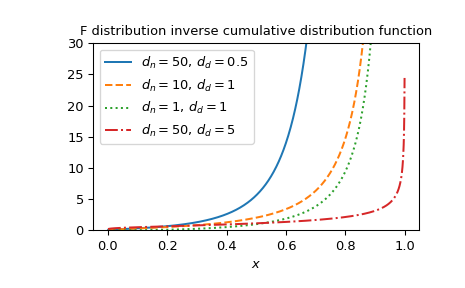scipy.special.fdtri#
- scipy.special.fdtri(dfn, dfd, p, out=None) = <ufunc 'fdtri'>#
F-分布的第 p 个分位数。
此函数是 F 分布 CDF
fdtr的逆函数,返回使得 fdtr(dfn, dfd, x) = p 的 x。- 参数:
- dfnarray_like
第一个参数(正浮点数)。
- dfdarray_like
第二个参数(正浮点数)。
- parray_like
累积概率,在 [0, 1] 之间。
- 出ndarray,可选
函数值的可选输出数组
- 返回:
- x标量或ndarray
对应于 p 的分位数。
参见
fdtrF 分布累积分布函数
fdtrcF 分布生存函数
scipy.stats.fF 分布
注释
计算是基于逆正则化beta函数的关联进行的,\(I^{-1}_x(a, b)\)。设 \(z = I^{-1}_p(d_d/2, d_n/2)\)。
\[x = \frac{d_d (1 - z)}{d_n z}.\]如果 p 满足 \(x < 0.5\),则为了提高稳定性,使用以下关系:设 \(z' = I^{-1}_{1 - p}(d_n/2, d_d/2).\)
\[x = \frac{d_d z'}{d_n (1 - z')}.\]F 分布也可以通过
scipy.stats.f获得。直接调用fdtri可以提高性能,相比于scipy.stats.f的ppf方法(见下文最后一个示例)。参考文献
[1]Cephes 数学函数库, http://www.netlib.org/cephes/
示例
fdtri表示 F 分布 CDF 的逆函数,该函数以fdtr的形式提供。在这里,我们计算df1=1,df2=2在x=3处的 CDF。然后,fdtri在给定相同的 df1, df2 值和计算出的 CDF 值的情况下返回3。>>> import numpy as np >>> from scipy.special import fdtri, fdtr >>> df1, df2 = 1, 2 >>> x = 3 >>> cdf_value = fdtr(df1, df2, x) >>> fdtri(df1, df2, cdf_value) 3.000000000000006
通过为 x 提供一个 NumPy 数组,在多个点上计算函数。
>>> x = np.array([0.1, 0.4, 0.7]) >>> fdtri(1, 2, x) array([0.02020202, 0.38095238, 1.92156863])
绘制几个参数集的函数图。
>>> import matplotlib.pyplot as plt >>> dfn_parameters = [50, 10, 1, 50] >>> dfd_parameters = [0.5, 1, 1, 5] >>> linestyles = ['solid', 'dashed', 'dotted', 'dashdot'] >>> parameters_list = list(zip(dfn_parameters, dfd_parameters, ... linestyles)) >>> x = np.linspace(0, 1, 1000) >>> fig, ax = plt.subplots() >>> for parameter_set in parameters_list: ... dfn, dfd, style = parameter_set ... fdtri_vals = fdtri(dfn, dfd, x) ... ax.plot(x, fdtri_vals, label=rf"$d_n={dfn},\, d_d={dfd}$", ... ls=style) >>> ax.legend() >>> ax.set_xlabel("$x$") >>> title = "F distribution inverse cumulative distribution function" >>> ax.set_title(title) >>> ax.set_ylim(0, 30) >>> plt.show()

F 分布也可以通过
scipy.stats.f获得。直接使用fdtri通常比调用scipy.stats.f的ppf方法快得多,特别是在处理小数组或单个值时。要获得相同的结果,必须使用以下参数化:stats.f(dfn, dfd).ppf(x)=fdtri(dfn, dfd, x)。>>> from scipy.stats import f >>> dfn, dfd = 1, 2 >>> x = 0.7 >>> fdtri_res = fdtri(dfn, dfd, x) # this will often be faster than below >>> f_dist_res = f(dfn, dfd).ppf(x) >>> f_dist_res == fdtri_res # test that results are equal True